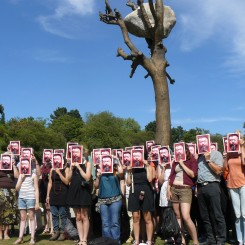A Critical Response to Ai Weiwei’s Comments on the Exhibition “Art of Change” at the Hayward Gallery (read Iona Whittaker’s review here).
The Hayward Gallery’s latest exhibition, “Art of Change: New Directions from China,” opened recently to almost universally positive reviews that in almost every case reflected a mixture of pleasure and fascination. While some reviewers expressed uncertainty with regard to the precise significance of individual works, most shared the view that the exhibition presents fresh insights into the relationship between contemporary art and society within China, and in particular contemporary Chinese art’s critical engagement with authority.
This combination of impressions is perhaps unsurprising. In spite of almost daily media coverage, China remains something of an unknown quantity. Consequently, most UK-based reviewers lack the detailed knowledge required to place contemporary Chinese art. At the same time, there is something compelling about an art whose meanings remain only partially grasped but that is self-evidently engaged in a complex relationship with the extraordinary changes now taking place within contemporary China.
One reviewer, however, was not impressed. In his comments published by the Guardian on 10 September the Chinese artist and activist Ai Weiwei launched a scathing attack on the organisers of “Art of Change,” accusing them of misrepresenting contemporary art in China. In Ai’s view, the show fails to address any of China’s most “pressing contemporary issues” and in particular the fact that there is within China currently “no room for freedom of expression.” Contemporary art in China is, Ai argues, “merely a product” that “avoids any meaningful engagement” and whose only purpose outside China is therefore “to charm viewers with its ambiguity”. It seems unlikely that Ai has actually seen the show or read its accompanying catalog since he is still subject to effective house arrest in Beijing.
In recent years Ai Weiwei has become a familiar media presence within the UK. Interminable online rants, scathing public attacks on officialdom, headline-grabbing exhibitions and artworks, a series of police beatings, life-threatening hospitalization, a BBC documentary by Alan Yentob, captivity without trial, a high-profile prosecution for “tax evasion,” a certificated whip-round among friends and associates to pay the bill and, more recently, a cinematic self-portrait of the artist as unreconstructed non-conformist have secured Ai’s place not only as a commentator of first choice on the subject of contemporary art in China but also as a spectacular personification of resistance to Chinese authoritarianism. No television, radio or newspaper coverage of contemporary Chinese art would be complete without at least a passing reference to Ai as China’s best-known and perhaps most significant living artist. He is the UK media’s Chinese cultural equivalent to Aung San Suu Kyi; a sanctified beacon of opposition now partially silenced by house arrest though still evidently raging against the injustices meted out to himself and to others at the hands of the Chinese authorities.
In spite of its liberalizing social and economic reforms of the last three decades, China remains a place of often breathtaking political brutality. Open challenges to the authority of China’s ruling communist party as well as anything that might be perceived to undermine the integrity of the Chinese nation-state are, as they were throughout the Maoist period, simply beyond the political pale. The consequences of transgression — extra-judicial harassment of self and family, detention, exile and even death — persist in being both real and pernicious. However, with the increasingly precipitous unfolding of post-socialist modernity within China since the late 1970s limits on freedom of action and expression have become ever-more mobile and ill-defined. As a result, panoptical self-surveillance and self-discipline as well as spectacular demonstrations of state power and growing material wealth are now the combined bulwarks of China’s prevailing socio-political order. Direct use of state violence is deemed necessary only in relation to extreme or recidivist dissidence. Ai continues to remind us of these thoroughly nasty and objectionable facts not only through his various acts of open resistance to authority but also the state of home confinement he now finds himself in. His constant baiting of authority and refusal to bow to intimidation has resulted in a Kafkaesque backlash the mere prospect of which would terrorize most of us into lasting and abject silence. For his defiance in the face power Ai deserves our continuing attention and respect.



